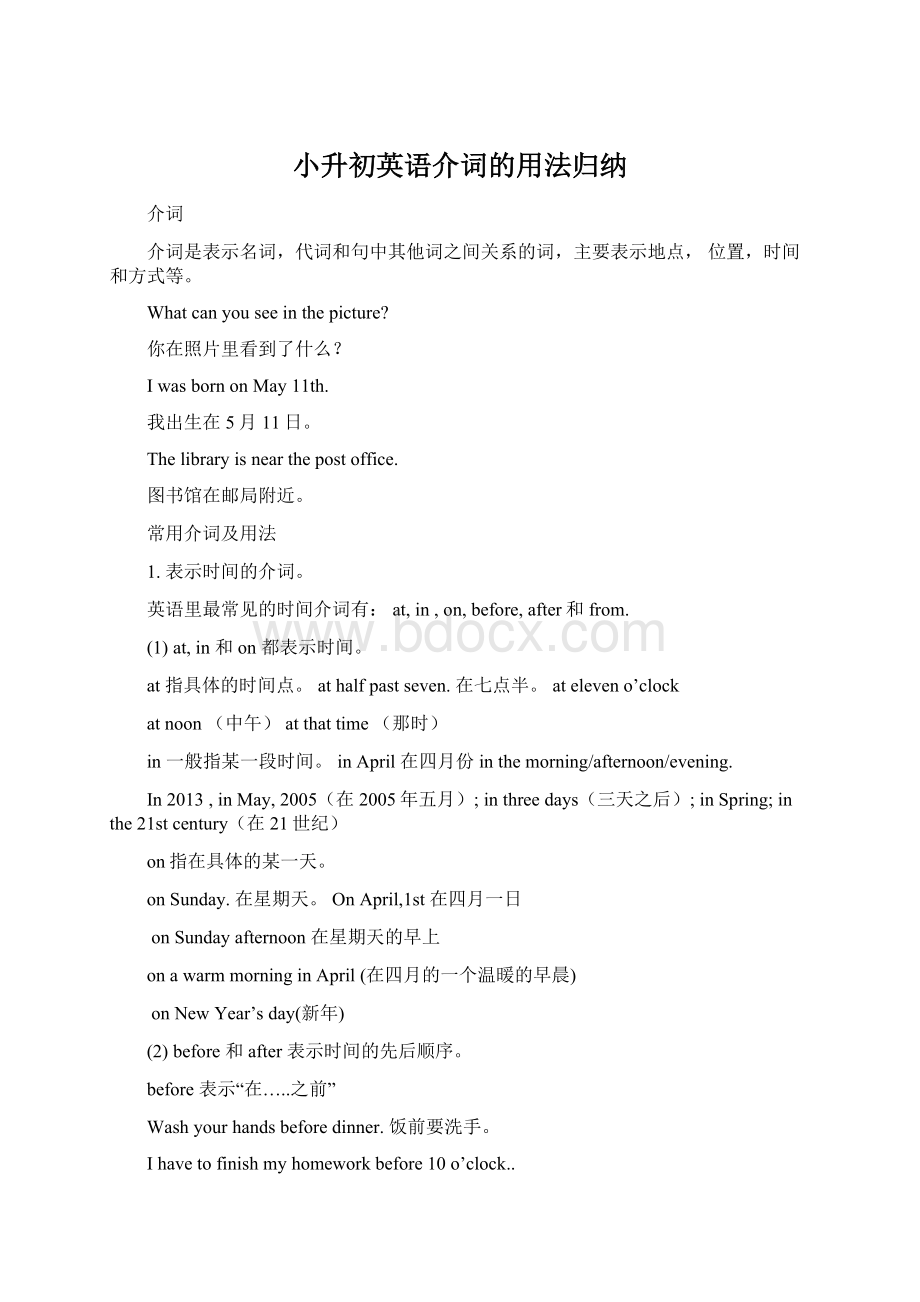 小升初英语介词的用法归纳.docx
小升初英语介词的用法归纳.docx
- 文档编号:7716295
- 上传时间:2023-01-26
- 格式:DOCX
- 页数:10
- 大小:111.10KB
小升初英语介词的用法归纳.docx
《小升初英语介词的用法归纳.docx》由会员分享,可在线阅读,更多相关《小升初英语介词的用法归纳.docx(10页珍藏版)》请在冰豆网上搜索。

小升初英语介词的用法归纳
介词
介词是表示名词,代词和句中其他词之间关系的词,主要表示地点,位置,时间和方式等。
Whatcanyouseeinthepicture?
你在照片里看到了什么?
IwasbornonMay11th.
我出生在5月11日。
Thelibraryisnearthepostoffice.
图书馆在邮局附近。
常用介词及用法
1.表示时间的介词。
英语里最常见的时间介词有:
at,in,on,before,after和from.
(1)at,in和on都表示时间。
at指具体的时间点。
athalfpastseven.在七点半。
ateleveno’clock
atnoon(中午)atthattime(那时)
in一般指某一段时间。
inApril在四月份inthemorning/afternoon/evening.
In2013,inMay,2005(在2005年五月);inthreedays(三天之后);inSpring;inthe21stcentury(在21世纪)
on指在具体的某一天。
onSunday.在星期天。
OnApril,1st在四月一日
onSundayafternoon在星期天的早上
onawarmmorninginApril(在四月的一个温暖的早晨)
onNewYear’sday(新年)
(2)before和after表示时间的先后顺序。
before表示“在…..之前”
Washyourhandsbeforedinner.饭前要洗手。
Ihavetofinishmyhomeworkbefore10o’clock..
我不得不在十点之前做完作业。
after表示“在….之后”,
Theyoftenplayfootballafterschool.
他们放学后经常踢足球。
MyfatheroftenwatchesTVafterdinner.
我爸爸经常在晚饭后看电视。
(3)from表示时间时,常和to连用,构成from…to…的结构,表示“从…..到…..”的意思。
Hekeptonworkingfromseventotwelvelastnight.
他昨晚从起点到12点一直在工作。
IgotoschoolfromMondaytoFriday.
2.表示方位的介词。
小学阶段常见的方位介词有on,in,at,under,over,above,below,about,around,between等。
(1)on,over和above
相同点:
三者均有“在….上面”的意思。
不同点:
on表示两个物体的表面相互接触。
—Whereisthepen?
—It’sonthebox
over表示“在….的正上方”,两个物体的表面没有接触。
above表示两个物体中一个在另一个的上方,但不一定垂直,两个物体间也没有接触。
Thereisabookonthedesk.
桌子上有一本书。
Theskyisoverourheads.
天在我们的头顶上。
Theplaneisflyingaboveclouds.
飞机在云上飞行。
(2)under和below
相同点:
两者均表示“在….的下面”的意思。
不同点:
under表示“在….的正下方”,其反义词是over.
overunder
Thereisaballovertwoboxes.
Thereisaballunderabox
Thereisabridgeovertheriver.
河上有座桥。
below表示“在…..的下面”,但只是低于某一点,不强调是否在正下方。
Fromthetopofthehill,wecouldseetheblueoceanbelow.
我们从山顶上能看到下边的蓝色大海。
Thedeadseaisbelowsealevel.
死海的海面低于海平面。
(3)in表示位置,意为“在…里面”,也可以用来表示在一个很大的空间内。
Maryworksinabank.
玛丽在银行工作。
Thereisn’tacloudinthesky.
天空中没有一片云。
What’sinthebox?
Heputhishandsinhispockets.
他把手放入口袋。
(4)at表示“在某地点”。
Iwillwaitforyouatthestation.
我将在车站等你。
(5)around和about均表示“在…周围”。
Theysataroundthetable.
他们围着桌子而坐。
Wewalkedaboutthetown.
我们在镇周围走。
(6)behind表示“在…..的后面”。
Thereisabroombehindthedoor.
门后边有一把扫帚。
(7)infrontof表示“在……的前面”。
Thereisanewwhitecarinfrontofthehouse.
那房子前面有一辆白色的新轿车。
(8)between表示“在两者之间”。
Mybedroomisbetweenmytwosisters’.
我的卧室在两个姐妹的卧室之间。
(9)表示“在某地”时,at后面接小地方,in后接大地方。
如:
athome在家atthebusstop在汽车站inChina在中国intheworld在世界上
3.表示动向的介词。
在英语钟,有一类介词表示一种动态的移动,有“朝着……”和“向着……”的意思。
小学阶段常见的动向介词有into,outof,up,down,from,to,across,through,along等。
(1)into和outof
Into表示“从外向里”的意思;outof表示“从里向外”的意思。
Isawthemgointothehouse.
我看见他们进了那间房子。
Lilyranoutoftheclassroom.
莉莉跑出了教室。
(2)up和down
up表示“向上”,down表示“向下”。
Weclimbedupthemountaintothetop.
我们爬上了山顶。
Sheopenedthedoorandwentdownthestairs.
她开了门下楼去了。
(3)across和through
相同点:
两者都表示“通过,穿过”的意思。
不同点:
across.[ə'krɔs]
表示“穿过”这一动作在某个物体的表面进行。
Hewalkedacrosstheroadcarefully.
他小心地穿过马路。
Theduckisswimmingacrosstheriver.
这只鸭子正在游过河。
Heisswimmingacrossthepool.
他正在游过游泳池。
through.[θru:
]
表示“穿过”这一动作在某个物体的空间内进行。
Shewalkedthroughtheforestalone.
她独自一人走过森林。
Thetrainisgoingthroughthetunnel(隧道)。
这辆火车正在穿过隧道。
Hewantstoclimbintotheroomthroughthewindow.
他想从窗户爬进房间。
4.表示方式的介词
表示方式的介词主要有by,with,in等。
(1)by表示“靠,用”。
Mymothergoestoworkbybus.
我妈妈乘公共汽车上班。
(2)with表示“使用,和….一起;有,具有,带有”。
Hecutthecakewithaknife.
他用小刀切开了那个蛋糕。
(3)in表示“用某种语言,以某种方式”。
ShecanspeakinJapanese
基础训练
将下列词组翻译成汉语。
1.onthefarm___________________2.bytrain______________________
3.theboyinwhite__________________4.afterschool___________________
5.underthechair____________________6.atnight____________________
7.infrontoftheclassroom_________________________
8.onSaturdaymorning__________________
9.behindthetree_______________________
10.neartheriver__________________________
一选择括号内恰当的介词填空。
1.Children’sDayis_____________(at/on/in)the1stofJune.
2.Thegirl_____________(with/on/in)longhairismysister.
3.Tomdoesn’tdowell_________(at/on/in)math.
4.Lookatthemonkeys____________(between/on/in)thetree.
5.Wehaveskirts_________(under/behind/in)red,greenandwhite.Whatcolordoyoulike?
6.Tomsellshiscomputergame____________(with/for/to)me.
7.Sheisafriend________(of/to/on)mysisters’.
8.Here’sanicepicture___________(with/to/for)you.
9.Pleasecallme____________(at/to/with)23479865.
10.What’sthis_________(at,on,in)English?
二单项选择
()1.—What’sthis_________English?
—It’sanapple.
A.onB.inC.atD.of
()2.Lily,canyougoshopping______me?
A.nearB.atC.withD.from
()3.Englishisspoken________American.
A.inB.atC.byD.with
()4.Itoftenrains_______June.
A.ofB.inC.atD.on
()5.Theyarewaitingforabus_________thebusstop.
A.inB.toC.onD.at
()6.—Whatdidyoudo_______thefarm?
—Weplantedsometreesforthefarmers.
A.onB.inC.atD.to
()7.Thegirl________whiteandredismysisterKate.
A.forB.ofC.inD.with
()8.Thewaterway(运河)iswideenoughformanyshipstopass_________.
A.aboveB.acrossC.crossD.through
()9.Writethenumbers_______10________30ontheblackboard.
A.from;inB.between;andC.behind;andD.among;in
()10.Thechildrenareplanning__________theirclassproject.
A.ofB.forC.withD.about
()11.Tomwasborn_______Aprilthe1st,andIwasborn_______April,too.
A.in;inB.in;onC.on;inD.on;on
()12.IsPolly________thetree?
A.atB.inC.onD.after
()13.Doesyourmothercook_______you_____theweekend?
A.for;onB.for;atC.with;onD.to;at
()14.Igetup______aboutsevenfiftyfive.
A.inB.onC.atD.for
()15.It’scold________winterinShenYang.
A.atB.inC.onD.to
()16.What’swrong________yourbike?
A.inB.onC.atD.with
()17.Thanks_________yourhelp.
A.toB.forC.inD.on
()18.Iknowthename_______thegirl.
A.inB.onC.of
()19.—Ishisbook________thedrawer?
—No,it’s_______thedesk.
A.in,inB.on,onC.at,onD.in,on
()20.Bobwasborn_______May12th,1999.
A.inB.atC.onD.mustn’t
三根据汉语意思,完成句子。
1.李明很擅长唱歌。
LiMingisgood_______singing.
2.爸爸对我要求很严格。
Myfatherisstrict________me.
3.李华坐在教室中间。
LiHuasits_______themiddle______theclassroom.
4.这本书和那本书不一样。
Thisbookisdifferent_________thatbook.
5.在朋友的帮助下,我通过了数学考试。
Withthehelp________myfriend,Ipassedthemathsexam.
四完成对话。
A:
Excuseme,canyoushowmetheway______theBank_______China?
B:
Oh,doyouknowthepostoffice?
Thebankis______________it.
A:
I’mnewhere,Idon’tknowthecitywell.
B:
CanIgo_______you?
A:
That’sgreat.
B:
Whereareyou_________?
A:
Sydney,How__________you?
B:
I’m_________GuiLin.
A:
It’saplaceofinterest.
B:
Welcome________GuiLin.
五找出句中错误的一项并改正。
1.Therearetwopicturesinthewall.
ABCD
()改为__________________
2.Sheusuallygoestoschoolonbus.
ABCD
()改为___________
3.Whatcanyouseeonthepicture?
ABCD
()改为____________
4.MygrandmotherwentshoppingandmysisterlastSunday.
ABCD
()改为_______________
5.CanyouwriteitonChinese?
ABCD
()改为_________________
六选择适当的介词填空。
oninatbywithnear
underbehindinfrontof
1.Ioftenhavebreakfast______7:
30.
2.LiTaoalwaysgoestoschool________taxi.
3.Myhomeisnotfarfrommyschool.Itis________myschool.
4.Thereisplentyofwater_______theground.
5.Lilyhides_________thedoor.
6.Wehavethreemathlessons_______aweek.
7.Pleasewritealetter__________ink.
8.Therearesomeapples_______thetree.
9.Isyourmother_______home?
10.IalwayshelpKim________hisEnglish.
七英汉互译
(1)inMay____________
(2)infrontofthecinema_______________________
(3)amapoftheworld______________________
(4)inthewest________________(5)在湖上_______________________
(6)在家里___________________(7)在树后面______________________
(8)在下午一点________________(9)来自日本___________________
(10)进来____________________
- 配套讲稿:
如PPT文件的首页显示word图标,表示该PPT已包含配套word讲稿。双击word图标可打开word文档。
- 特殊限制:
部分文档作品中含有的国旗、国徽等图片,仅作为作品整体效果示例展示,禁止商用。设计者仅对作品中独创性部分享有著作权。
- 关 键 词:
- 小升初 英语 介词 用法 归纳
 冰豆网所有资源均是用户自行上传分享,仅供网友学习交流,未经上传用户书面授权,请勿作他用。
冰豆网所有资源均是用户自行上传分享,仅供网友学习交流,未经上传用户书面授权,请勿作他用。


 铝散热器项目年度预算报告.docx
铝散热器项目年度预算报告.docx
